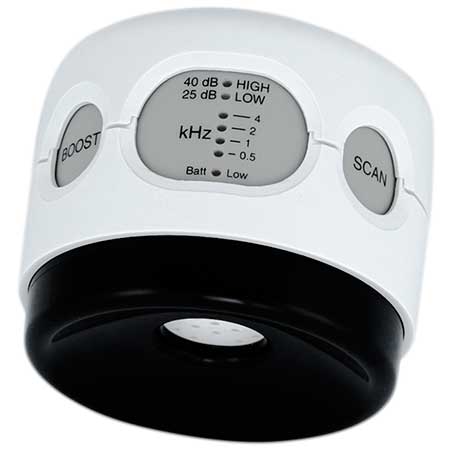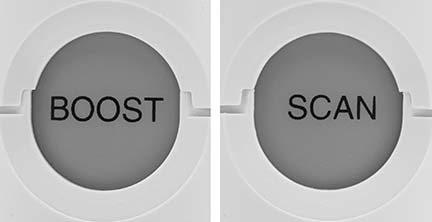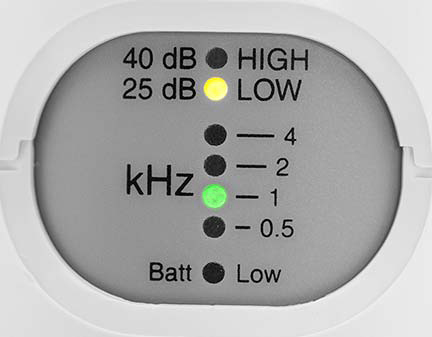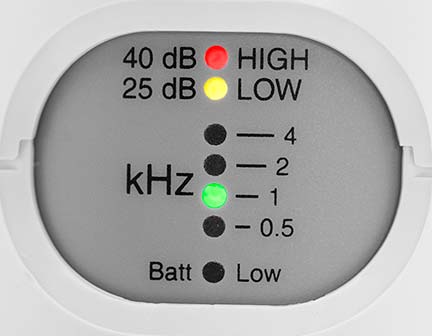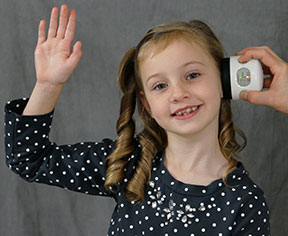INTRODUCTION
The OtoScreen III hearing screener has two buttons, a ”Scan” button and a “Boost” button. See figure 1. The Scan button initiates a tone when held down and sequences through the four frequencies (500, 1000, 2000 and 4000 Hertz) when pressed and released. The Boost button increases the sound level from the threshold tone level to 40 dB HL.
The threshold sound level is 20 dB HL for a Pediatric unit and 25 dB HL for a Standard unit. Pediatric units have a turquoise colored switchplate and Standard units have a gray colored switchplate. The illustrations in this manual are for a Standard unit.
BASIC OPERATING INSTRUCTIONS
- Press and hold the Scan button down with your thumb. The unit turns on and a green light indicates that the 1000 Hz tone is selected. A yellow light comes on after one second indicating that a tone is being presented. See figure 2. The one-second delay is to eliminate any finger noise from influencing the test.
- Release then press and hold the Scan button again to advance to the next frequency. A yellow light comes on after one second indicating that a new tone is active. A tone is only presented to a subject when the Scan button is held down. Releasing the Scan button immediately turns a tone off.
- The green lights always indicate which frequency is active.
- Quickly pressing and then releasing the Scan button advances the unit to the next frequency without presenting a tone. This is useful when you want to skip a tone, repeat a tone or present tones in a different order.
- To increase the sound level to 40 dB, press the “Boost” button with your index finger while the Scan button is also being pressed. A red light turns on indicating that the unit is outputting a 40 dB tone. See figure 3.
- Releasing the Boost button returns the sound level to the threshold level.
Become familiar with operating the unit before using it to screen a subject for hearing loss.
Your unit should be calibrated every 1-2 years. Check your State regulations. Go to www.HearingScreeners.com for information about re-calibrating your unit.
PRACTICE SEQUENCE OF BUTTON PUSHES (video shown on right of screen)
The video on the right of the screen is demonstrating the following sequence of button "pushes" and plays in a continuous loop. You can "mouse over" and pause the video if desired.- The sequence starts when no LEDs are on. The Scan button is pressed and held down; this turns on the unit. The 1 kHz green LED light turns on. The Scan button is still held down and in 1 second the yellow 25 dB LED turns on indicating the LOW tone is being presented (20 db for Pediatric units). A tone is only presented when the Scan button is held down and the yellow LED light is on.
- Next the Scan button is released and then pressed and held down again. The frequency advances to 2 kHz and in 1 second the yellow LED comes on indicating a tone is being presented. The green LED always indicates the active frequency. The 1 second delay helps to remove finger noise from influencing the test.
- The Scan button is released and held down 2 more times to present the 4000 Hz and the 500 Hz LOW tones. Notice that as soon as the Scan button is released the yellow LED shuts off indicating no tone is present.
- Next the Scan button is pressed and quickly released 4 times. This advances the frequency without presenting a tone.
- On the 5th press the Scan button is held down until the yellow LED turns on. Then the Boost button is also pressed to engage the HIGH 40 dB sound level. The Boost button only works when the Scan button is pressed and held down first.
- Next the Scan button is released and then held down again. The frequency advances to 2 kHz and the yellow LED turns on indicating a tone is being presented. Then the Boost button is also pressed to engage the HIGH 40 dB sound level.
- The above step is repeated 2 more times to sequence through the other frequencies presenting a LOW and then a HIGH tone.
- Last, the Scan button is pressed and quickly released to return to the starting 1 kHz freqency of this practice sequences of button pushes. The yellow LED is off so no tone is presented.
There are many different ways to use the OtoScreen III to screen hearing. Following is one possible method.
STEP ONE – TALK TO THE SUBJECT
- For successful screening there needs to be good communication with the subject. Talk to the subject before any screening begins so there is a mutual understanding about what responses are expected.
- Explain to the subject to raise their hand or finger when they hear something and lower their hand or finger when they don’t. See figure 4.
- For young children simplify the communication and make it fun. The child could wiggle their nose and say “princess” or “cowboy” instead of raising a hand or finger. Be creative!
STEP TWO – QUICK CHECK
Do the following quick-check sequence to see if the subject is hearing all the tones:
- Place the unit over one of the subject’s ears centered on their ear canal.
- Press and hold the Scan button until the yellow light comes on. If the subject doesn’t raise their hand, make a note that further testing is needed.
- Release and press the Scan button again. If the subject doesn’t raise their hand, make a note that further testing is needed.
- Repeat the above step as many times as necessary to get a consistent result for all frequencies. The 500 Hz test should be omitted if the testing environment is not very quiet.
- Repeat all of STEP TWO for the other ear
STEP THREE – VERIFY HEARING PROBLEMS
- For each ear and each frequency the subject didn’t raise their hand (or lowered their hand) in STEP TWO above, scan the unit to that frequency and hold the Scan button down until the yellow light turns on and a tone is presented.
- If the subject doesn’t raise their hand indicating a tone is present, immediately press the Boost button to increase the sound level to 40 dB to see if the subject can hear the louder tone.
- If they don’t raise their hand for either the threshold sound level or the 40 dB sound level, there is a good probability there is hearing loss at that frequency.
- Subjects less than 65 years old should be able to hear tones at both the threshold dB level and the 40 dB sound level. Subjects 65 years and older are only required to hear the tones at 40 dB.
- Repeat STEP THREE as many times as necessary to get a consistent result.
STEP FOUR – REFER
- Refer the subject for more detailed testing if a hearing loss is detected.
Click the "S-O-A-R" button on the left for pass/fail criteria
